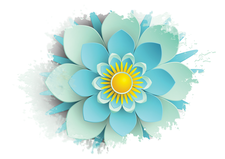Photorealistic images with vector graphics
Visual Math

What are vector graphics and how could we make them better?
Have you ever wondered why you can zoom in on a piece of text in your web browser, PDF viewer, or word processor, and it still retains the smooth look it had at the original scale? In comparison, zooming in on a web image generally yields a pixelated or ragged-looking result. What gives text this resolution-independent property, and is it possible to extend this property to graphics in general?
Understanding Vector Graphics
A discussion of computer graphics should begin with the observation that there are two types of graphics: raster graphics and vector graphics. You're probably quite familiar with raster graphics – rectangular grids composed of individually colored pixels. Zooming in on a pixel-based raster image eventually results in either a blocky picture or a somewhat smoother result that often looks a bit blurred. This blurring or distortion is caused by an interpolation algorithm that generates new pixel data for the magnified version based on the values of neighboring pixels. On the other hand, vector graphics relies on mathematical descriptions of curves. These descriptions are resolution-independent, which means that vector graphics can scale without losing quality. The glyphs of a font that you look at on your screen are examples of vector graphics in daily life. If you're interested in taking a closer look at the curves defining these characters, install FontForge [1] (or alternatively, Birdfont [2]), and open a font you're interested in (commonly stored in /usr/share/fonts).
For a deeper look at vector graphics, it is very useful to install a dedicated vector graphics editor – the open source Inkscape is an excellent choice. Start by adding a circle, a (rounded) star, and a single character from your favorite font. Set the fill of all objects to none and the stroke to a solid light gray. Then, with all three selected, choose the option Path | Object to Path. Viewing the resulting paths in edit mode (F2) with everything selected should yield a result similar to the images in Figure 1.
[...]
Buy this article as PDF
(incl. VAT)
